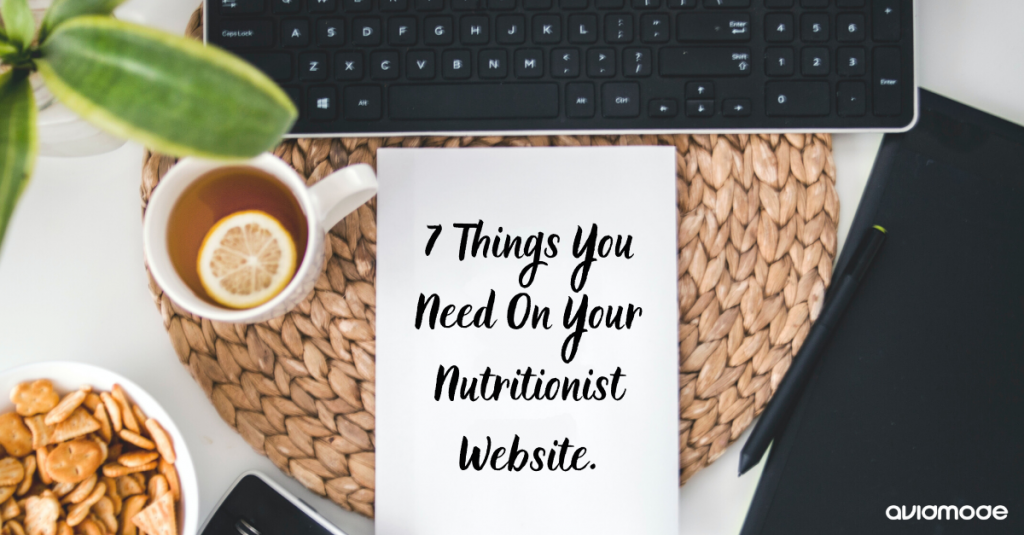7 things that you need on your nutritionist website
Is the idea of building or revamping your nutritionist website already sending your brain into a mess of questions and worries? You’ve decided that it’s time that you start working…

Is the idea of building or revamping your nutritionist website already sending your brain into a mess of questions and worries?
You’ve decided that it’s time that you start working on your website so that you can take advantage of all the leads that it could be generating you, great!
But, the problem is… what really needs be on your website to reach those all important readers and succeed?
Spotlight on you
Many businesses in the health and wellness sector are headed up by a single person, if this sounds like you, you should make sure that your website reflects your personality and vibe – your clients will be working with you directly after all.
Some nice ways that you can implement this into the website;
- Creating a magazine style foreword to your page that gives the reader an immediate flavour of who you are.
- Good quality photos of you through the website, this makes the website much more personal.
- An about page that provides your clients with clarity about how you can attend to their needs whilst still getting to know you as a person.
Blog
Blogging is a fantastic way to show off all your knowledge. As a nutritionist, the range of content that you could explore is endless – especially as trends come and go through the years. A blog really enables you to delve into a topic for your clients and it signals to the search engines that you are running a moving and shaking business.
Topics for your blog posts could include;
- Recipes
- Nutrition and Body Education
- Seasonal Topics – Weight Loss, Beach Ready, Healthy Christmas Food
- Mental Health Awareness/Body Image/Guilt
All of these give you the opportunity to show the reader that you have a passion for your subject and that you’re willing to help solve issues that they are regularly coming up against.
Testimonials/As Seen On
This is a super important function of the website – after they’ve read about you and how you can help with their health issues they’ll want to hear from people who’ve already used your services in the past.
The testimonials on your website are your cheerleaders, they can subconsciously give a reader confidence that making the choice to use you is backed up by research and facts.
All testimonials should be specific to the page you’re using them on. If you have a service page on your website speaking about family nutrition, you’ll want a testimonial section on the page showing off reviews and comments from past clients who have used your service.
As for the “As Seen On” section. You’ll want a place to show off the logos of the brands that you’ve worked with or media that you’ve been seen on. This is usually separated out from testimonials as it trust signals in a slightly different way but it just fits nicely into the same category. If you’ve written articles for magazines, been interviewed on television or have books that you’ve already written, this will be a must have section.
Community Tools
When it comes to health and wellness you’ll usually come across a lot of people who are having similar issues. When this happens you are in the perfect position to start off a community. Community building these days is often something that you do with the help of social media platforms but you can use your website as a tool to help boost your community.
Some ways that you might do this include;
- Creating community events that you host on an annual basis, something that you can promote through the website – such as a summit or a weekend community getaway.
- Sometimes nutritionists can benefit from setting up forums on their own websites, if you’d rather not use Facebook or other social media as your main tool for communicating with your community you might think about having a different friendly place that people will connect directly with you.
- Online courses, this can be a great way to get a community going as you have similar minded people doing the same course and all relating to each other. If your nutritionist business has some sort of a course function, why not think about moving it online and integrating some community tools.
Sign Up Function
On most nutritionist websites, you’ll want some sort of a sign up sheet. Some businesses might only use it for email marketing (in the form of newsletters for example), others might use it as a way to get people to book into their events, courses or one to one sessions. Whatever it is that you sell as a business, you’ll want to provide the reader with a way to connect with you.
Many websites use sign up, pop up forms. These don’t always work and can sometimes be more annoying than useful. It just depends on what you want people to sign up to and where your website is placed on your readers buyer journey.
Other places that you can include these forms are;
In the footer of your website, usually on the home page or on the individual service pages. Remember, if you have more than one service, you want to make sure that the sign up is relevant to the page that your slotting it into.
Services Pages
We’ve spoken a little bit about the individual components that you want to have across your website but we haven’t delved too much into your pages. When thinking about the website, you want it to be easy to navigate – this means you don’t want to give endless options. Before the website building process, take a little time to sit down and think about the products or services that you want to sell and how they might mesh together.
Here is a quick example of some services;
Family Nutritionist – Works with family groups to set people on the right path to be healthier and make the most of their time in the kitchen.
Suggested services: Online Meetings, 121 Consultations, Community Cooking Events.
School Nutritionist – Works with schools, teaching pupils and educators how to create healthy diets to help them through the school day. Offering workshops and consultations on the best lunches to provide for their pupils.
Suggested services: Workshops, 121 Consultations, Lesson Planning.
Sports Nutritionist – Works with athletes to get the most out of their diet when it comes to performance. Does talks at events, creates meal plans for athletes in conjunction with coaches.
Suggested services: Demonstrations, Workshops, Talks, 121 Coaching.
Those are just three types of nutritionists and the services that they provide. Each of the services would usually benefit from their own individual page on the website. This helps the reader to self segregate into the type of service they’d like from you and they’ll head straight for the page that speaks to them.
Resources
Finally, let’s talk about the resources that you might be able to provide. As a nutritionist, there is a lot of information that you have that can be used in a variety of different ways to attract clients. Having a specific area for resources is a great way of intriguing a reader, having access to resources means that the client thinks that they are getting something for free. Now, you don’t have to give away all the details on these pages, but it might be worth thinking about what you could offer as teasers.
Here are some that might work for your business:
- Video series – could be on cooking for a family, educating the viewer on the body or giving insight into your own personal journey with nutrition.
- Recipes – If you love to create recipes for people, why not have a recipe resource. The more pictures the better here!
- Podcast – If you don’t like to get in front of the camera but you love to talk about what you do then a podcast might be a great resource for you to provide.
Again, those are just a few of the options that would really catch the eye of your readers.
So, that covers off the “7 Things That You Need On Your Nutritionist Website”, we covered a lot of ground here today and this post hopefully got you thinking about some of the aspects that might play into your website build or overhaul. The trickiest part to deal with a nutritionists’ website is finding a good balance between the right amount of information to give for free and what to sell. The components in this post should help nail down some ways that you can give to your reader without spilling all the beans.
One of the things that we really love to do as a business is help make you feel more comfortable with your website and at the same time give you an understanding of how it can work for you!
If you’ve recently taken a look at your website and think it needs a little TLC or are starting a new nutritionist business and need a website, then we’d love to have a chat.
If you enjoyed reading this blog post, check out similar ones in the sidebar. Feel free to get in touch with to chat about your latest project ideas - we love a good excuse for more tea.


